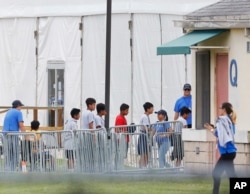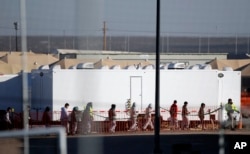Decades after the U.S. stopped institutionalizing kids because large and crowded orphanages were causing lasting trauma, it is happening again. The federal government has placed most of the 14,300 migrant toddlers, children and teens in its care in detention centers and residential facilities packed with hundreds, or thousands, of children.
As the year draws to a close, some 5,400 detained migrant children in the U.S. are sleeping in shelters with more than 1,000 other children. Some 9,800 are in facilities with 100-plus total kids, according to confidential government data obtained and cross-checked by The Associated Press.
That's a huge shift from just three months after President Donald Trump took office, when the same federal program had 2,720 migrant youth in its care; most were in shelters with a few dozen kids or in foster programs. Some of the children may be released sooner than anticipated, because this week the administration ended a portion of its strict screening policies that had slowed the placement of migrant kids with relatives in the U.S.
Until now, public information has been limited about the number of youths held at each facility overseen by the Office of Refugee Resettlement, even for attorneys representing the kids. But the AP obtained data showing the number of children in individual detention centers, shelters and foster care programs for nearly every week over the past 20 months, revealing in detail the expanse of a program at the center of the Trump administration's immigration crackdown.
The data shows the degree to which the government's approach to migrant youth has hardened, marking a new phase in a federal program originally intended to offer safe haven to vulnerable children fleeing danger across the globe. It's been taking at least twice as long, on average two months rather than one, for youth held inside the system to get out, in part because the Trump administration added more restrictive screening measures for parents and relatives who would take them in.
That changed Tuesday when the administration ended a policy requiring every adult in households where migrant children will live to provide the government with fingerprints. All still must submit to background checks, and parents themselves still need to be fingerprinted. Nonetheless, officials said they could now process some children more rapidly, and hoped to shorten shelter stays that had dragged on so long kids sometimes wondered if their parents had abandoned them for good.
"It's a pain we will never get through,'' said Cecilio Ramirez Castaneda, a Salvadoran whose 12-year-old son, Omar, was taken from him when they were apprehended in June under the administration's "zero tolerance'' policy, which led to nearly 3,000 children being separated from their families. Omar feared his father had given up on him during the five months he spent in a Southwest Key shelter in Brownsville, Texas, with dozens of kids.
Ramirez was reunited with Omar last month only to learn that his son had been hospitalized for depression and medicated for unclear reasons and suffered a broken arm while in government custody.
"It's a system that causes irreparable damage,"he said. "My son says they would tell him that because he wasn't from here, he had no rights."
Experts say the deep anxiety and distrust children suffer when they're institutionalized away from loved ones can cause long-lasting mental and physical health problems. It's dangerous for all but worse for younger children, those who stay more than a few days and those who are in larger facilities with less personal care.
"This is not a perplexing scientific puzzle. This is a moral disaster,'' said Dr. Jack Shonkoff, who heads Harvard University's Center on the Developing Child. "There has to be some way to communicate, in unequivocal terms, that we are inflicting punishments on innocent children that will have lifelong consequences. No matter how a person feels about immigration policy, very few people hate children — and yet we are passively allowing bad things to happen to them.''
Administration officials said increased need has driven them to expand the number of beds available for migrant children from 6,500 last fall to 16,000 today. Mark Weber, a spokesman for the U.S. Department of Health and Human Services, which oversees ORR, said sheltering children in large facilities, while not preferable, is a better alternative than holding them for long periods at Border Patrol stations ill-suited to care for them.
"This is an amazing program with incredibly dedicated people who are working to take care of these kids,'' he said. "There are a large number of children and it's a difficult situation, and we are just working hard to make sure they are taken care of and placed responsibly.''
Weber confirmed a number of specific shelter populations from the data the AP obtained. To further verify the data, reporters contacted more than a dozen individual facilities that contract with ORR to house migrant children. Reporters also cross-referenced population numbers previously collected by AP and its partners.
The kids in government care range in age from toddlers to 17. The vast majority crossed the border without their parents, escaping violence and corruption in Central America, but some were separated from their families at the border earlier this year.
The care they receive varies greatly in the opaque network, which has encompassed 150 different programs over the last 20 months in 17 states. Some children live with foster families and are treated to Broadway shows, while others sleep in canvas tents exposed to the elements amid the Texas desert.
Through dozens of interviews and data analysis, AP found:
— As of Dec. 17, some 9,800 children were in facilities housing more than 100 kids; 5,405 of those were in three facilities with more than 1,000 youths — two in Texas and one in Florida.
— Texas had the most growth over the last 20 months in the number of kids under ORR custody. In April 2017, there were 1,368 migrant children in facilities or foster care in Texas. As of Dec. 17, the number was about 8,700.
— New York had the second-highest number of children: 1,653, up from 210 in April 2017. Cayuga Centers grew from about 40 kids to close to 900; all are in foster homes.
— The five largest providers, in order, are Austin, Texas-based Southwest Key; San Antonio-based BCFS Health and Human Services; Comprehensive Health Services Inc., based in Cape Canaveral, Florida; Cayuga Centers in Auburn, New York; and Chicago-based Heartland Alliance. Together they had about 11,600 children — or more than 80 percent of the 14,314 migrant youth in ORR custody as of Dec. 17.
— The states with children in care are: Arizona, California, Connecticut, Florida, Illinois, Kansas, Massachusetts, Maryland, Michigan, New Jersey, New York, Oregon, Pennsylvania, South Carolina, Texas, Virginia and Washington state.
Kids continue to enter the system, though dozens of the care providers have been sued or disciplined before for mistreating children in their care. Now new litigation is piling up as attorneys fight to get migrant children released.
Staff members at a Southwest Key shelter in Phoenix allegedly physically abused three children this year, leading to the closure of the shelter in October, federal officials said. And a lawsuit filed earlier this year alleged that Latino youths at the Shenandoah Valley Juvenile Center in Virginia were beaten while handcuffed and locked up for long periods in solitary confinement, left nude and shivering in concrete cells.
The American Academy of Pediatrics and many experts warn against institutionalizing children in large groups. Dr. Ryan Matlow, a Stanford clinical psychologist whose work addresses the impact of early life stress, said best practices minimize the number of children in any one shelter.
"Children are being treated as cogs in a machine, and their individual backgrounds, interests and unique identities are devalued as they are lost amongst the masses. This experience then becomes internalized, with significant psychological consequences,'' said Matlow, who recently met with migrant children in custody. "There is no way in which a mass detention setting can replicate the experience and support that comes from family and community.''
The number of migrant children caught by immigration officials and then turned over to the Office of Refugee Resettlement has dropped under Trump: there were 49,100 in fiscal year 2018 compared to a high of 59,170 in fiscal year 2016, when a surge of youth crossing the border prompted the Obama administration to open emergency shelters at military bases. The average length of stay has increased, however, from about 34 days in January 2016 to around 60 days , according to government reports. In October, the average length of stay reached 89 days, according to data HHS provided to members of Congress, who shared it with AP.












